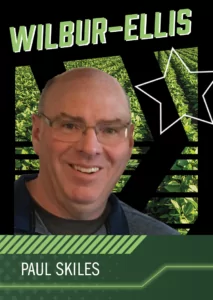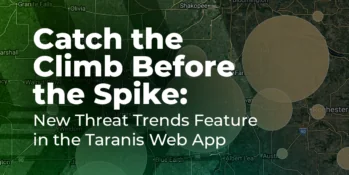

 With 30 years of experience helping growers find the solutions that work for them, Wilbur-Ellis Sales Agronomist, Paul Skiles, has seen his share of challenging growing seasons and done his part to put technologies and opportunities in the hands of growers when they need them most.
With 30 years of experience helping growers find the solutions that work for them, Wilbur-Ellis Sales Agronomist, Paul Skiles, has seen his share of challenging growing seasons and done his part to put technologies and opportunities in the hands of growers when they need them most.
“I’ve been with Wilbur-Ellis for a little over three years now, and what drew me to the position was the amount of high-level service we provide across field-level activities,” Skiles shares. “That’s what excites me; I just want to be in the field with the grower, working to help make better decisions that increase yield and profitability.”
Any agronomist will tell you that there are no two days alike in their line of work—Skiles concurs. His days are filled with not only working with growers to implement the micro-level changes that gain bushels on the yield monitor at the end of the growing season. He is also spending significant time scouting to validate his recommendations.
An ardent adopter of new technologies, Skiles leverages his 30 years of agronomic and retail experience to find an intersection of products, services, and technologies that best serve Wilbur-Ellis customers. He shares that he doesn’t ever want to feel like he is in a rut, recommending the same prescriptions year after year.
“It doesn’t matter what it is in life; you always have to be moving forward. Ag technology is part of the future, and it’s coming fast. If you don’t adopt and adapt, you will get left behind, which means that your customers will get left behind,” he says. “It all comes down to making better decisions faster.”
In his lifetime, Skiles says that the game changers have been soil sampling on a grid, GPS, and the imagery that creates directive scouting, noting that all save time and money and create a better roadmap to success.
“You can only cover so many acres in a day. When you can go to a “good” spot and figure out why something is working or to the “bad” spot and figure out what you need to fix, it just creates efficiency and makes you a better resource for your customer.”
Rounding out their second growing season as a Taranis customer, Wilbur Ellis has leveraged AcreForward Crop Intelligence to help their customers get the most out of crops plagued by drought, weed, and insect pressures.
“All of the pretty pictures that Taranis provides are great, the information is great, but then you start taking those pretty pictures out to the field. When you can walk with a customer to a spot in a field, using those pictures, and tell them the story behind what you are both seeing, it blows them away. Ground truthing is another touchpoint with a customer that this tool provides,” Skiles says, adding that the excitement begins right after planting with a clear and accurate stand count assessment.
Using Taranis, Skiles and his team have been able to create planting prescription maps that allow customers to micromanage population.
He shares that Taranis is also a good way for him to start his day productively.
“The first thing I do in the morning is look at the dashboard. It’s an easy program to use with percentages and colors. If I have 10,000 acres on the dashboard, there’s no way I could cover that on foot in a week,” he explains. “With Taranis, I can review 10,000 acres before I have my first cup of coffee down and start planning my day from there. I know exactly where I need to go and have an idea of what I’m going there for. There just isn’t any wasted time.”
In Beresford, South Dakota, Skiles’ retail location base, growers saw their third year of what he calls “dismal” crops due to the ongoing drought. He shares that while the seasons have started off strong for the past two years, late June has seen them begin to wilt and wither, leaving poor yield conditions for many of the customers he serves. Even with poor yields, Skiles says that Taranis has proven to be a tool that customers are willing to invest in.
“Our biggest challenge has been trying to complete the season and the drought, but the insights that we have been able to get, like stand count and disease information, has made the case for the value of Taranis,” he says.
Using the dashboard, Skiles can look at a grower’s fields that have high disease in them, isolate those areas, split a few stalks, and let them know that they are going to have stalk issues. That information puts him in a position to let his growers know that their crop isn’t going to get any better and will be flat with the first windstorm—it gives them the advantage of knowing which fields to start on and makes a case for starting harvest earlier than they normally would.
Taranis insights are also proving to be a game changer for Skiles as he works to keep track of invasive and costly diseases.
“It was the number of diseases out there that we weren’t picking up, and the diseases that we didn’t think were in this area that was eye-opening. Brown stem rot and downy mildew were two surprises I didn’t expect this year. We’ve seen hints of brown stem rot, but not to the level we saw this year. Taranis insights even suggested that we may have had some sudden death syndrome, which we’ve never seen in this area. I was able to pull plants, and they are being tested to verify,” he adds.

Stay ahead of emerging crop threats with the new Threat Trends feature in the Taranis Web App. Track 7-day trends in disease and weed pressure across regions and make proactive decisions with confidence.

Scouting used to mean walking fields and hoping to catch problems in time.

Sometimes, zooming in isn't enough. You need to step back to see the full picture. That’s where Wide Angle Weeds comes in.